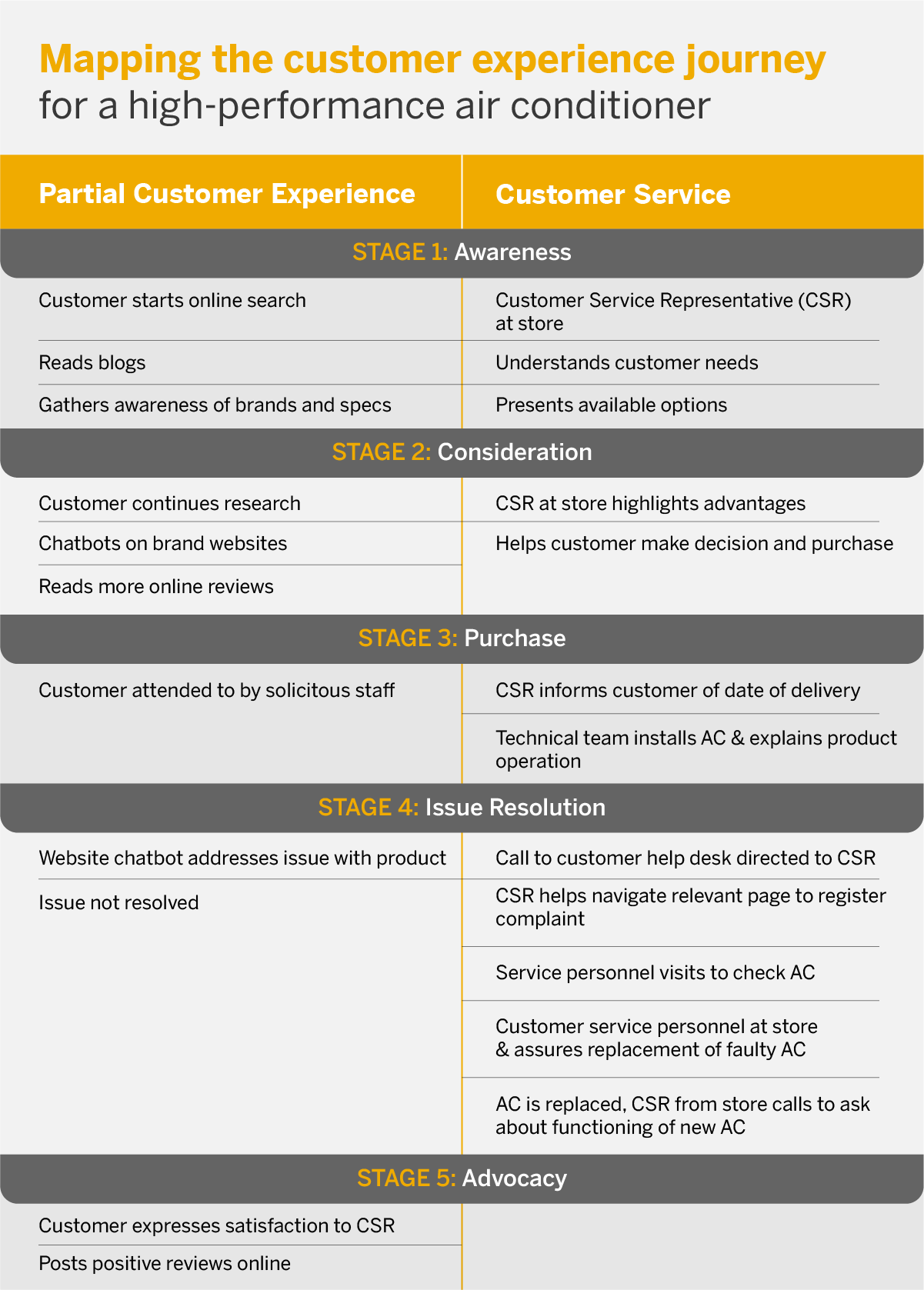Have you ever been confused by the terms customer experience and customer service? Most people are. The terms customer service and customer experience are used interchangeably by laypersons. Customer service is just one piece of the jigsaw puzzle that is customer experience. One cannot take the place of another. One cannot be easily compared with the other, because one is a part of another.
Let’s explore the differences between customer experience and customer service. Customer experience Is the entire journey or interaction that a customer has with an organization, right from shortlisting a product, filling out paperwork, paying for it, getting it installed, getting it serviced, enjoying the experience and planning future purchases from the same brand or store.
Customer experience is proactive. It involves anticipating customer needs and chalking out the customer journey from the discovery of a business to the first purchase, post purchase service and continued purchases.
Customer service is reactive. It almost always involves the customer reaching out to the company or brand for help or a need or service. It could be through a phone, website, social media, email or live chat. Customer service is just one component of customer experience. It involves the customer interacting with various touchpoints/personnel in multiple departments during the course of his/her customer experience journey. Each interaction of a customer with a customer touchpoint or employee can be described as a customer service component.
Both — a great customer experience and excellent customer service — are important for the success of an organization. One is dependent on the other. Customer experience could turn out to be a lifelong journey of interaction between a brand and a customer. Even a one-off episode of excellent customer service can turn a first-time customer into a loyal patron for a lifetime. Enhancing customer service is an essential element of best-in-class customer experience strategies. Given below is a fictional account of a customer experience journey, which will better explain the difference between customer experience and customer service.
A customer experience journey takes off

The above hypothetical example succinctly delineates the difference between customer experience and customer service. It also highlights how an exceptional customer experience strategy can do wonders to the overall customer experience, and in turn customer service, and ensure loyalty of customers.
As the world turns increasingly digital, the importance of empowering a customer and the customer service team digitally becomes all the more important. Flexibility, speed and efficiency become the cornerstones of a customer experience strategy when digitally enabled through the cloud. Let’s check out what are the benefits of digitalizing an organization’s customer experience strategy.
Digitalizing customer experience strategies
It is important for businesses to provide customers with a seamless, hassle-free customer experience to ensure customer loyalty and boost brand reputation. To achieve this, a business has to invest in digitalising its customer service, empowering its team with a digital platform that provides an omni-channel customer experience to patrons.
Choosing a scalable customer service platform that can expand to take on the needs of a growing customer base, powered by technology that is up-to-date and efficient, is the first step towards a cutting-edge customer experience strategy.
A digital customer service platform is designed to accommodate the latest trends in customer support. It can be customized to help an organization set metrics and goals, and monitor metrics to achieve those goals.
A cloud-based digital customer service platform can provide analytical data reports, which can help an organization predict the future needs of a customer and proactively address them. The reports can provide history and trends for each customer, which can be analyzed and monitored to improve customer experience strategy across channels.
The organization can maintain detailed records of all interactions across channels— whether on chat, email, social media, portal or app. It provides service personnel with context and insights, and tools and information, to support the customer and resolve pain points. It can help the service and sales teams cater to the entitlement and narcissist need of each customer to be treated as a unique individual and be serviced accordingly.
A digitally-enabled customer experience strategy and platform can help build a knowledge base that can be updated continuously to benefit both customers and employees. Customers can register their suggestions and customer surveys can provide qualitative feedback across touchpoints to improve customer experience.
Why digital is good for the customer service team
An organization can respond and offer service to a customer 24/7 regardless of location with a cloud-based digital customer service solution. It can deliver help across a medium that works best for the customer, be it a video call, app or online self-service. It gives customers the freedom to decide how they engage with an organization. The customer can move across channels while interacting with the organization, and the service and marketing teams can connect with the customers seamlessly as they are on the move.
Real-time service with live chat that the customer service team can deliver the moment a customer lands on a website, can transform customer transaction outcomes. Chatboxes can be configured to maintain simple conversations in multiple languages, and to hand over the call to agents when it goes beyond their capabilities. They can be trained to be more accurate over time with accumulated data and machine learning based training.
A cloud-based customer service solution can help bring up information related to an organization to the top of search results with powerful search engine optimization. Customers can easily find accurate, up-to-date information about the company and its products on search engines and service portals. Customers today are averse to long waiting times for service and query resolution. A cloud-enabled customer service platform gives customers an opportunity for self-service and to figure out things for themselves. It can provide a customer with instant and precise information — anytime, anywhere.
Providing customers with a seamless, intuitive customer service platform can result in them finding answers to a large number of their queries themselves, which would otherwise have landed at the desk of call center agents. This frees up the time of agents to tackle more complex issues that need their urgent attention, resolving which can build on customer relationships and loyalty. It reduces operational costs and the load on call centers by reducing redundant questions. It provides customers with quick answers and speedy resolution of issues.
Call center agents, on the other hand, have access to comprehensive information on customers, collated from across multiple channels, at the click of a button. Dashboards can be populated with the requisite information necessary for each transaction from across platforms. They have a 360-degree view of customers in front of them when they deal with them. This gives them the history and past behavior of customers and enables them to deal with them tactfully and suggest the best solutions. They can win over the customer easily to increase first-contact resolution rates. It also reduces the stress on the call center agents and keep them engaged to cross-sell and up-sell as they deal with the customers. A cloud-based digital customer service solution can also automate routine repetitive tasks that lead to human error, freeing up employees for more critical duties.
How digital customer experience strategies boost productivity
Streamlined routing and scheduling of tasks is essential for efficient workflow management and maximising the productivity of the customer service team. A digitally optimized customer service solution can deploy the best-equipped agent to address a customer query or request. It can assign customers to agents based on scope of work and priority, ensuring that high-priority cases are resolved quickly. The solution can also identify the most-competent customer care representatives so that their knowledge can be channeled to train others. A digital customer service solution can identify where exactly customers are facing problems in their customer experience journey and steer them to a solution based on their past history and behavior.
As the business environment and needs change, customer care representatives have to work remotely as well as in the field. A digital customer service solution provides mobile applications that can equip an agent to service customers from a device of their choice, even when away from the desk. It provides customer service personnel with the latest technology to make their jobs easier and effective.
Powerful analytical tools can aid management to monitor customer service and marketing teams in real time. Performance metrics and key performance indicators, tailored to organizations’ needs, can vitalize service and marketing teams’ performance. Quantitative reports can provide clear direction to improvement.
Seamless sharing of information is a core component of a well-crafted customer experience strategy. A cloud-enabled digital customer service solution can centralize information and data storage. Teams can collaborate and share information. All employees are included in the information loop and can access customer data to provide swift, comprehensive and personalized customer service. Predictive dashboards can help to understand, monitor and improve customer service operations in the long term. Centralization of data can equip marketing and service teams to collaborate to provide standout customer experiences across touchpoints and build enduring relationships.
Apps and websites can be connected to the digital customer service platform, so that the team does not miss out on any opportunity to service customer requests. The customer service platform can be integrated with other operating software to improve internal and external communication and make it possible for the organization to work like a well-oiled machine.
Conclusion
Many organizations have experienced the above-mentioned benefits after transitioning to a cloud-based digital customer experience strategy. They have realized how a cloud-based digital customer service solution can enhance the customer focus of an organization; how it can provide the teams with tools, controls and visibility to meet and exceed customer expectations each and every time, across the range of channels they interact with them.
The revamping and modernizing of customer experience strategies in these organizations have helped them provide customers with seamless omni-channel service experiences that build customer trust and loyalty. It has helped organizations adopt intelligent technologies that have enhanced employee satisfaction, engagement and excellence. It has upped the customer service teams’ motivation to maximize customer satisfaction to the best of their ability. It has improved contribution, collaboration, performance and productivity of teams.
The interdependent relationship that customer experience and customer service share, where one cannot exist without the other and where one fortifies the other, is amply clear with the above detailed exposition. The digitalization of customer experience strategy and customer service will further serve to strengthen both and, in turn, positively impact organizations’ operational costs, growth, bottom line and turnover.
To find out how to accelerate your journey to becoming digitally resilient and setting yourself up for success in the long run, find out how you can integrate SAP Service Cloud into your operations, a comprehensive customer service solution that supports great omnichannel customer experiences and contact centre efficiency.



